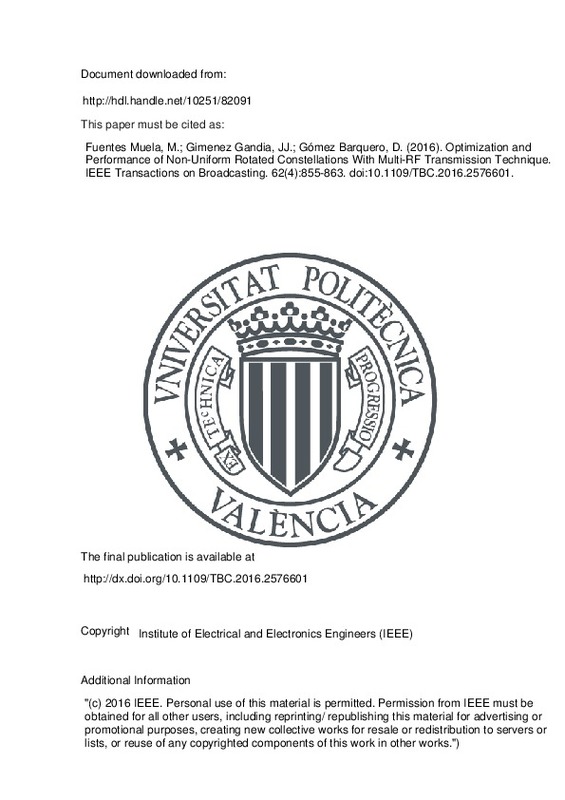JavaScript is disabled for your browser. Some features of this site may not work without it.
Buscar en RiuNet
Listar
Mi cuenta
Estadísticas
Ayuda RiuNet
Admin. UPV
Optimization and Performance of Non-Uniform Rotated Constellations With Multi-RF Transmission Technique
Mostrar el registro sencillo del ítem
Ficheros en el ítem
| dc.contributor.author | Fuentes Muela, Manuel
|
es_ES |
| dc.contributor.author | Giménez Gandia, Jordi Joan
|
es_ES |
| dc.contributor.author | Gómez Barquero, David
|
es_ES |
| dc.date.accessioned | 2017-05-31T11:12:05Z | |
| dc.date.available | 2017-05-31T11:12:05Z | |
| dc.date.issued | 2016-12 | |
| dc.identifier.issn | 0018-9316 | |
| dc.identifier.uri | http://hdl.handle.net/10251/82091 | |
| dc.description | "(c) 2016 IEEE. Personal use of this material is permitted. Permission from IEEE must be obtained for all other users, including reprinting/ republishing this material for advertising or promotional purposes, creating new collective works for resale or redistribution to servers or lists, or reuse of any copyrighted components of this work in other works.") | es_ES |
| dc.description.abstract | Non-Uniform Constellations (NUC) have been introduced in ATSC 3.0 (Advanced Television Systems Committee - Third Generation) as one of the main novelties to improve the performance compared to uniform Quadrature Amplitude Modulation (QAM) constellations. NUCs are optimized by means of signal geometrical shaping, considering the signal-to-noise ratio (SNR) and the channel model. ATSC 3.0 implements two types of NUC, depending on the number of real-valued dimensions in which they are optimized: 1D-NUC and 2D-NUC. However, the gain of NUCs becomes almost non-existent at high SNRs, especially when optimizing for fading channels. In that particular case, Rotated Constellations (RC) can be used to further improve the overall system performance. RCs may become especially effective when using multi-radio frequency (multi-RF) SNR averaging techniques such as Channel Bonding (CB) or Time-Frequency Slicing (TFS), where in-phase (I) and quadrature (Q) components are transmitted in different RF channels. 2D-NUCs can be rotated without increasing the demapping complexity, since a 2D-demapper is also needed. In this paper, we propose an optimization method designed for rotated 2D-NUCs, in which the rotation angle is considered as an additional variable, together with the symbol positions. The SNR gain obtained in fading channels is also provided for three different use cases: single-RF transmissions, CB with 2 RF channels as adopted in ATSC 3.0, and extension of multi-RF techniques to 4 RF channels. | es_ES |
| dc.description.sponsorship | This work was supported by the Ministry of Economy and Competitiveness of Spain, through the European FEDER Fund under Grant TEC2014-56483-R. | en_EN |
| dc.language | Inglés | es_ES |
| dc.publisher | Institute of Electrical and Electronics Engineers (IEEE) | es_ES |
| dc.relation.ispartof | IEEE Transactions on Broadcasting | es_ES |
| dc.rights | Reserva de todos los derechos | es_ES |
| dc.subject | DTT | es_ES |
| dc.subject | Non-Uniform Constellations | es_ES |
| dc.subject | Rotated Constellations | es_ES |
| dc.subject | Channel Bonding | es_ES |
| dc.subject | ATSC 3.0 | es_ES |
| dc.subject | Time-Frequency Slicing | es_ES |
| dc.subject.classification | TEORIA DE LA SEÑAL Y COMUNICACIONES | es_ES |
| dc.title | Optimization and Performance of Non-Uniform Rotated Constellations With Multi-RF Transmission Technique | es_ES |
| dc.type | Artículo | es_ES |
| dc.identifier.doi | 10.1109/TBC.2016.2576601 | |
| dc.relation.projectID | info:eu-repo/grantAgreement/MINECO//TEC2014-56483-R/ES/TECNOLOGIAS DE RADIODIFUSION DIGITAL EXTRA-TERRESTRES/ | es_ES |
| dc.rights.accessRights | Abierto | es_ES |
| dc.contributor.affiliation | Universitat Politècnica de València. Instituto Universitario de Telecomunicación y Aplicaciones Multimedia - Institut Universitari de Telecomunicacions i Aplicacions Multimèdia | es_ES |
| dc.description.bibliographicCitation | Fuentes Muela, M.; Giménez Gandia, JJ.; Gómez Barquero, D. (2016). Optimization and Performance of Non-Uniform Rotated Constellations With Multi-RF Transmission Technique. IEEE Transactions on Broadcasting. 62(4):855-863. https://doi.org/10.1109/TBC.2016.2576601 | es_ES |
| dc.description.accrualMethod | S | es_ES |
| dc.relation.publisherversion | http://dx.doi.org/10.1109/TBC.2016.2576601 | es_ES |
| dc.description.upvformatpinicio | 855 | es_ES |
| dc.description.upvformatpfin | 863 | es_ES |
| dc.type.version | info:eu-repo/semantics/publishedVersion | es_ES |
| dc.description.volume | 62 | es_ES |
| dc.description.issue | 4 | es_ES |
| dc.relation.senia | 322624 | es_ES |
| dc.contributor.funder | Ministerio de Economía y Competitividad | es_ES |







![[Cerrado]](/themes/UPV/images/candado.png)

